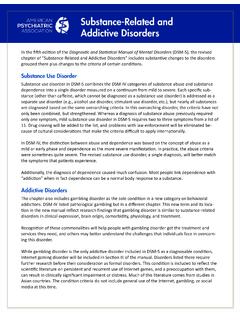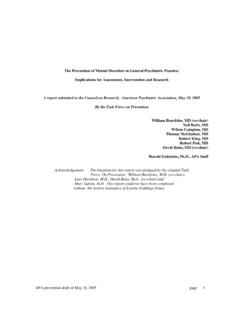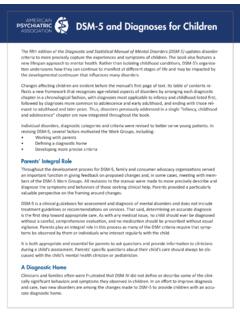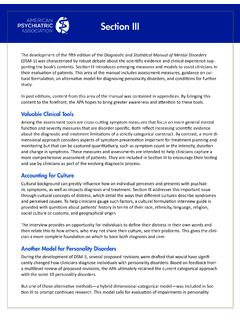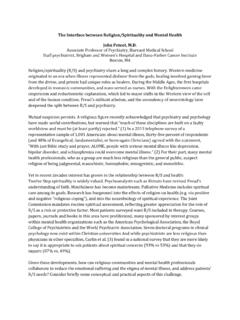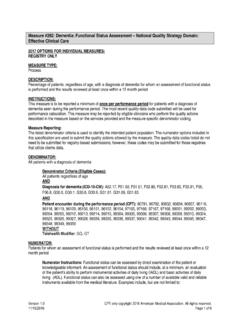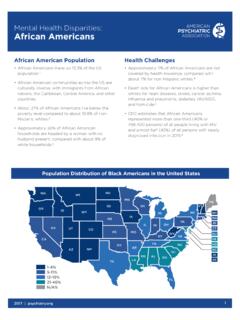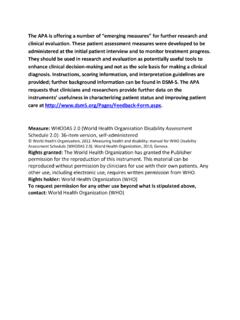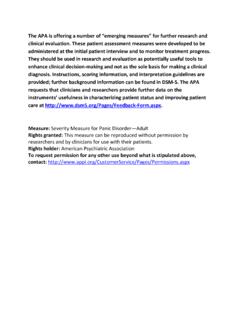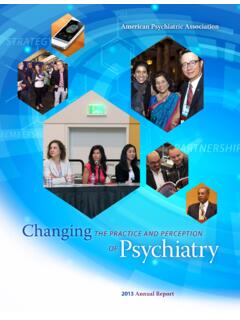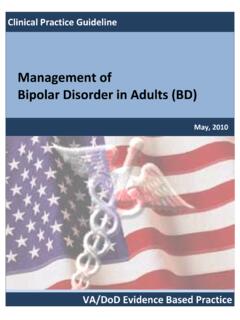Transcription of Highlights of Changes from DSM-IV-TR to DSM-5
1 Highlights of Changes from DSM-IV-TR to DSM-5 Changes made to the DSM-5 diagnostic criteria and texts are outlined in this chapter in the same order in which they appear in the DSM-5 classification. This is not an exhaustive guide; minor Changes in text or wording made for clarity are not described here. It should also be noted that Section I of DSM-5 con-tains a description of Changes pertaining to the chapter organization in DSM-5 , the multiaxial system, and the introduction of dimensional assessments (in Section III).TerminologyThe phrase general medical condition is replaced in DSM-5 with another medical condition where relevant across all DisordersIntellectual Disability (Intellectual Developmental Disorder)Diagnostic criteria for intellectual disability (intellectual developmental disorder) emphasize the need for an assessment of both cognitive capacity (IQ) and adaptive functioning.
2 Severity is determined by adaptive functioning rather than IQ score. The term mental retardation was used in DSM-IV. However, intellectual disability is the term that has come into common use over the past two decades among medical, educational, and other professionals, and by the lay public and advocacy groups. Moreover, a federal statue in the United States (Public Law 111-256, Rosa s Law) replaces the term mental retarda-tion with intellectual disability. Despite the name change , the deficits in cognitive capacity beginning in the developmental period, with the accompanying diagnostic criteria, are considered to constitute a mental disorder. The term intellectual developmental disorder was placed in parentheses to reflect the World Health Organization s classification system, which lists disorders in the International Classifica-tion of Diseases (ICD; ICD-11 to be released in 2015) and bases all disabilities on the International Classification of Functioning, Disability, and Health (ICF).
3 Because the ICD-11 will not be adopted for several years, intellectual disability was chosen as the current preferred term with the bridge term for the future in parentheses. Communication DisordersThe DSM-5 communication disorders include language disorder (which combines DSM-IV expressive and mixed receptive-expressive language disorders ), speech sound disorder (a new name for phono-logical disorder), and childhood-onset fluency disorder (a new name for stuttering). Also included is social (pragmatic) communication disorder, a new condition for persistent difficulties in the social uses of verbal and nonverbal communication. Because social communication deficits are one component of autism spectrum disorder (ASD), it is important to note that social (pragmatic) communication disorder cannot be diagnosed in the presence of restricted repetitive behaviors, interests, and activities (the oth-er component of ASD).
4 The symptoms of some patients diagnosed with DSM-IV pervasive developmen-tal disorder not otherwise specified may meet the DSM-5 criteria for social communication Spectrum DisorderAutism spectrum disorder is a new DSM-5 name that reflects a scientific consensus that four previously separate disorders are actually a single condition with different levels of symptom severity in two core 2 Highlights of Changes from DSM-IV-TR to DSM-5domains. ASD now encompasses the previous DSM-IV autistic disorder (autism), Asperger s disorder, childhood disintegrative disorder, and pervasive developmental disorder not otherwise specified. ASD is characterized by 1) deficits in social communication and social interaction and 2) restricted repetitive behaviors, interests, and activities (RRBs). Because both components are required for diagnosis of ASD, social communication disorder is diagnosed if no RRBs are DisorderThe diagnostic criteria for attention-deficit/hyperactivity disorder (ADHD) in DSM-5 are similar to those in DSM-IV.
5 The same 18 symptoms are used as in DSM-IV, and continue to be divided into two symp-tom domains (inattention and hyperactivity/impulsivity), of which at least six symptoms in one domain are required for diagnosis. However, several Changes have been made in DSM-5 : 1) examples have been added to the criterion items to facilitate application across the life span; 2) the cross-situational requirement has been strengthened to several symptoms in each setting; 3) the onset criterion has been changed from symptoms that caused impairment were present before age 7 years to several inattentive or hyperactive-impulsive symptoms were present prior to age 12 ; 4) subtypes have been replaced with presentation specifiers that map directly to the prior subtypes; 5) a comorbid diagnosis with autism spectrum disorder is now allowed; and 6) a symptom threshold change has been made for adults, to reflect their substantial evidence of clinically significant ADHD impairment, with the cutoff for ADHD of five symptoms, instead of six required for younger persons, both for inattention and for hyperactivity and impulsivity.
6 Finally, ADHD was placed in the neurodevelopmental disorders chapter to reflect brain developmental correlates with ADHD and the DSM-5 decision to eliminate the DSM-IV chapter that includes all diagnoses usually first made in infancy, childhood, or Learning DisorderSpecific learning disorder combines the DSM-IV diagnoses of reading disorder, mathematics disorder, disorder of written expression, and learning disorder not otherwise specified. Because learning deficits in the areas of reading, written expression, and mathematics commonly occur together, coded speci-fiers for the deficit types in each area are included. The text acknowledges that specific types of read-ing deficits are described internationally in various ways as dyslexia and specific types of mathematics deficits as DisordersThe following motor disorders are included in the DSM-5 neurodevelopmental disorders chapter: devel-opmental coordination disorder, stereotypic movement disorder, Tourette s disorder, persistent (chron-ic) motor or vocal tic disorder, provisional tic disorder, other specified tic disorder, and unspecified tic disorder.
7 The tic criteria have been standardized across all of these disorders in this chapter. Stereotypic movement disorder has been more clearly differentiated from body-focused repetitive behavior disor-ders that are in the DSM-5 obsessive-compulsive disorder Spectrum and Other Psychotic DisordersSchizophreniaTwo Changes were made to DSM-IV Criterion A for schizophrenia. The first change is the elimination of the special attribution of bizarre delusions and Schneiderian first-rank auditory hallucinations ( , two or more voices conversing). In DSM-IV, only one such symptom was needed to meet the diagnostic requirement for Criterion A, instead of two of the other listed symptoms. This special attribution was Highlights of Changes from DSM-IV-TR to DSM-5 3removed due to the nonspecificity of Schneiderian symptoms and the poor reliability in distinguishing bizarre from nonbizarre delusions.
8 Therefore, in DSM-5 , two Criterion A symptoms are required for any diagnosis of schizophrenia. The second change is the addition of a requirement in Criterion A that the individual must have at least one of these three symptoms: delusions, hallucinations, and disorganized speech. At least one of these core positive symptoms is necessary for a reliable diagnosis of subtypesThe DSM-IV subtypes of schizophrenia ( , paranoid, disorganized, catatonic, undifferentiated, and residual types) are eliminated due to their limited diagnostic stability, low reliability, and poor validity. These subtypes also have not been shown to exhibit distinctive patterns of treatment response or lon-gitudinal course. Instead, a dimensional approach to rating severity for the core symptoms of schizo-phrenia is included in Section III to capture the important heterogeneity in symptom type and severity expressed across individuals with psychotic DisorderThe primary change to schizoaffective disorder is the requirement that a major mood episode be pres-ent for a majority of the disorder s total duration after Criterion A has been met.
9 This change was made on both conceptual and psychometric grounds. It makes schizoaffective disorder a longitudinal instead of a cross-sectional diagnosis more comparable to schizophrenia, bipolar disorder, and major depres-sive disorder, which are bridged by this condition. The change was also made to improve the reliability, diagnostic stability, and validity of this disorder, while recognizing that the characterization of patients with both psychotic and mood symptoms, either concurrently or at different points in their illness, has been a clinical DisorderCriterion A for delusional disorder no longer has the requirement that the delusions must be non-bizarre. A specifier for bizarre type delusions provides continuity with DSM-IV. The demarcation of delusional disorder from psychotic variants of obsessive-compulsive disorder and body dysmorphic disorder is explicitly noted with a new exclusion criterion, which states that the symptoms must not be better explained by conditions such as obsessive-compulsive or body dysmorphic disorder with absent insight/delusional beliefs.
10 DSM-5 no longer separates delusional disorder from shared delusional dis-order. If criteria are met for delusional disorder then that diagnosis is made. If the diagnosis cannot be made but shared beliefs are present, then the diagnosis other specified schizophrenia spectrum and other psychotic disorder is same criteria are used to diagnose catatonia whether the context is a psychotic, bipolar , depres-sive, or other medical disorder, or an unidentified medical condition. In DSM-IV, two out of five symp-tom clusters were required if the context was a psychotic or mood disorder, whereas only one symp-tom cluster was needed if the context was a general medical condition. In DSM-5 , all contexts require three catatonic symptoms (from a total of 12 characteristic symptoms). In DSM-5 , catatonia may be diagnosed as a specifier for depressive, bipolar , and psychotic disorders ; as a separate diagnosis in the context of another medical condition; or as an other specified Highlights of Changes from DSM-IV-TR to DSM-5 bipolar and related DisordersBipolar DisordersTo enhance the accuracy of diagnosis and facilitate earlier detection in clinical settings, Criterion A for manic and hypomanic episodes now includes an emphasis on Changes in activity and energy as well as mood.
